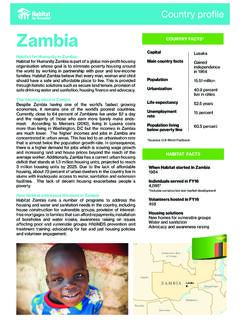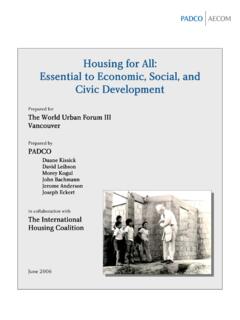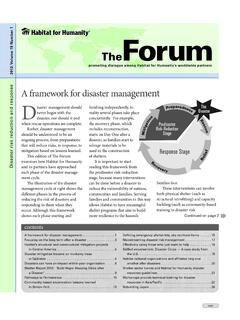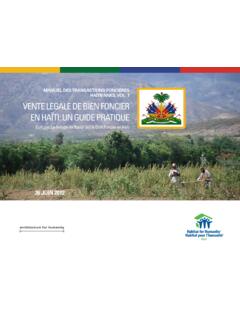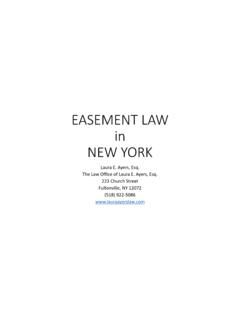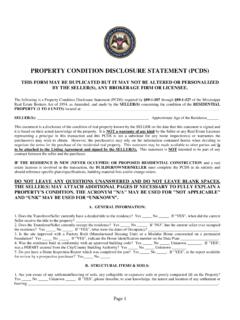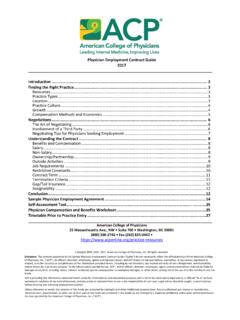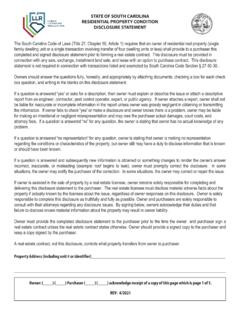Transcription of HOUSING POLICY AND RACIAL DISPARITIES AUGUST 2020
1 HOUSING POLICY AND RACIAL DISPARITIES AUGUST 2020 2 HABITAT FOR HUMANITY INTERNATIONAL Historic discrimination in HOUSING POLICY particularly discrimination against Black Americans is one of the chief drivers of RACIAL inequities that persist today. Organizations like Habitat that work on HOUSING must understand that history, and it must inform our work moving forward.. We must commit to doing the work in our practices, our programs and our networks that brings equity to our efforts and helps bring justice to the communities in which we work. We must, throughout our ministry, do a better job of connecting issues of RACIAL and social injustice with historic barriers to affordable HOUSING and working to eradicate those barriers.. In addition to being a space where people of all races, all faiths and all backgrounds can come together in common cause, we commit to being actively anti-racist and to affirming, through word and action, that Black Lives Matter and that our communities and systems must further this fundamental truth.
2 Jonathan Reckford, CEO, Habitat for Humanity International, June 12, 2020 HOUSING POLICY AND RACIAL DISPARITIES AUGUST 2020 3 HABITAT FOR HUMANITY INTERNATIONAL Foreword In June 2019, Habitat for Humanity launched its first national advocacy campaign in the , Cost of Home. Through coordinated POLICY efforts at the local, state and federallevels, the Cost of Home campaign seeks to help 10 million people access and afford a place to call home. When the campaign launched, the POLICY platform included this statement: Advocates and policymakers must acknowledge and address the well-documented historic patterns of RACIAL discrimination in HOUSING and land use policies at all levels of government that still impact the makeup and opportunities of our communities. The following POLICY paper expands on this statement by providing additional context to the history of HOUSING discrimination in the and how that history still profoundly impacts Black families today.
3 The paper concludes with recommendations for policymakers as the country looks to find viable, meaningful and impactful reforms to create a more racially equitable and just society. We hope it can be a helpful tool for starting the conversations and beginning the work needed to craft meaningful POLICY reforms that can ensure opportunities for all. Learn more about the Cost of Home campaign at HOUSING POLICY AND RACIAL DISPARITIES AUGUST 2020 4 HABITAT FOR HUMANITY INTERNATIONAL A. IntroductionThe events of 2020 have made vivid the urgent need for solutions that advance RACIAL equity. The disproportionate toll of the COVID-19 crisis on Black households, the continued killings of Black Americans at the hands of police, and the subsequent outpouring of protest have laid bare the stark RACIAL inequities and injustices that still permeate our institutions, policies and daily lives.
4 The United States must take bold action to redress the underlying inequities that continue to place households of color and especially Black Americans on very unequal footing in our country. We did not arrive at this moment by accident. A century of HOUSING and land use policies denied Black households access to homeownership, educational, credit, and neighborhood opportunities offered to white households. The consequences of these decisions are multigenerational and are vividly reflected in today s RACIAL DISPARITIES in HOUSING security, education, workforce opportunities, health, income and wealth. We have a moral obligation to rectify this harm and to correct those policies that continue to disadvantage Black households. Habitat for Humanity was born more than 40 years ago on a farm in southern Georgia built on the principle of radical, RACIAL inclusivity.
5 This intentional, interracial community was a place where people of all backgrounds worked together and lived together on equal terms, even though doing so put their lives in peril. The RACIAL inclusivity practiced on Koinonia Farm remains a core guiding principle in Habitat s work today. In the , Black families comprise 40% of the total families we assist in becoming homeowners. Non-white households as a whole comprise two-thirds. We further invest in communities of color by helping revitalize the neighborhoods where we work through inclusive, asset-based neighborhood development, cooperative partnerships and local leadership development. We multiply the impact of our work through advocacy to achieve a world where truly everyone can afford a decent and safe place to live and thrive.
6 Building on this history, we must now recommit ourselves to taking bold actions toward greater RACIAL equity. Our advocacy must address the systemic racism that has all too often played out in HOUSING POLICY . Habitat s Cost of Home campaign gives us critical tools for this endeavor. This paper examines the causes and extent of today s RACIAL HOUSING DISPARITIES and proposes five HOUSING POLICY strategies for remedying unequal conditions and opportunities for Black households so that everyone can thrive. Learn more about the history of Koinonia Farm, and its ongoing work, at HOUSING POLICY AND RACIAL DISPARITIES AUGUST 2020 5 HABITAT FOR HUMANITY INTERNATIONAL B. History of RACIAL inequities in HOUSING policyThe roots of RACIAL inequity in this country run centuries deep.
7 But too often overlooked are the more recent federal, state and local HOUSING policies that for decades denied Black households equal access to mortgage financing, neighborhoods with quality schools, neighborhood investment and federal homeownership subsidies made available to white households. Some policies, like local zoning codes and the federal mortgage interest deduction, continue to disadvantage Black households and those with lower incomes generally. Starting in the 1930s, the Federal HOUSING Administration began insuring private loans that would ultimately help millions of white families obtain affordable, low-down-payment mortgages and join the middle class. But this insurance was specifically denied to communities where Black households lived, through the practice of redlining.
8 Color-coded maps developed by the federal Home Owners Loan Corporation designated neighborhoods as unsafe for lending if they had an infiltration of households of color,1 and FHA made these communities ineligible for their new loan insurance. Private lenders followed FHA s lead. Residents in redlined communities were shut off from access to affordable homeownership. Racially restrictive covenants typically prevented Black households fr om living outside of redlined communities, and in the 1940s, FHA accelerated their use. FHA began subsidizing new subdivisions in emerging suburbs, but only on the condition that the homes be sold to white families with restrictive deeds that prohibited resale to Black families. This propelled the use of racially restrictive covenants nationwide and prevented Black families from buying homes in affordable, growing suburban communities and many city neighborhoods.
9 Governments at all levels enforced these After World War II, Black veterans were similarly excluded from participating in the GI Bill. The federal government provided veterans returning from the war with a subsidy in the form of a federally guaranteed, low-interest home loan with no down payment. But the loans were originated by private lenders who were free to refuse Black borrowers. And most did, since redlining had become standard prac tice in city neighborhoods where Black households could live, and RACIAL covenants prohibited Black homebuyers from purchasing homes in most other suburban and city Race-based exclusions from FHA-insured mortgages, FHA-subsidized suburbs, and the GI Bill put Black and white households on very different tracks. Between 1934 and 1962, households of color received just 2% of all government-backed In the decades that followed, Black families gained none of the equity appreciation that white homeowners would gain through access to new communities and these on-ramps to affordable homeownership.
10 In the 1950s, federally supported urban renewal began leveling many working-class Black and integrated neighborhoods, displacing renters, homeowners and business owners in the name of slum clearance. 5 Often these efforts made way for new downtown office development, civic spaces or large parking lots when private development never materialized. Meanwhile, new federally funded highways that were built to open up the suburbs frequently cut through Black neighborhoods, further displacing Black households, stripping Black homeowners of their properties, and forcing them to start over elsewhere. After passage of the Fair HOUSING Act in 1968, racially restrictive covenants were officially prohibited. But exclusionary zoning by wealth and income replaced exclusionary zoning by Learn more about the history of redlining from this video synopsis of The Color of Law by Richard Rothstein.
